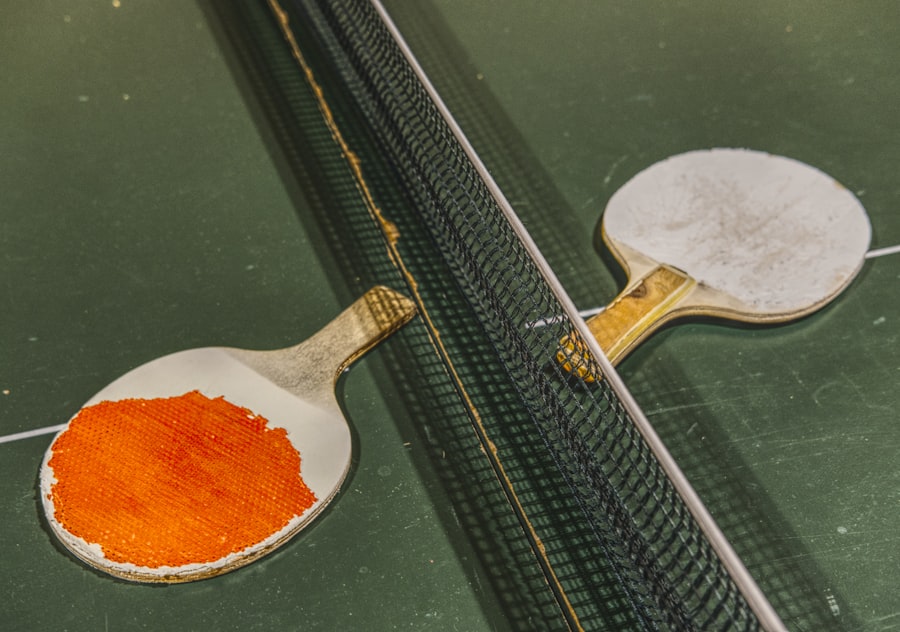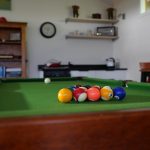Mastering the Art of Table Tennis
Description
Table tennis, often referred to as ping pong, is a fast-paced sport that combines agility, precision, and strategic thinking. Originating in England during the late 19th century as a parlor game, it has evolved into a highly competitive sport governed by the International Table Tennis Federation (ITTF). The game is played on a rectangular table divided by a net, with players using small paddles to hit a lightweight ball back and forth.
The objective is to score points by making the ball land on the opponent’s side of the table in such a way that they cannot return it. The standard dimensions of a table tennis table are 2.74 meters long, 1.525 meters wide, and 76 centimeters high. The net stretches across the width of the table, standing at 15.25 centimeters high.
Players compete in singles or doubles formats, with each player or team taking turns to serve. A match is typically played in a best-of-five or best-of-seven games format, with each game played to 11 points. Players must win by at least two points, adding an element of suspense and strategy as the score approaches the final stages of a game.
Key Takeaways
- Table tennis is a fast-paced game played on a small table with a lightweight ball and paddles.
- Mastering the serve and return is crucial for gaining an advantage in table tennis.
- Developing proper forehand and backhand techniques is essential for consistent and powerful shots.
- Good footwork and movement are key to getting into position for effective shots and quick returns.
- Understanding spin and control is important for manipulating the ball and keeping it in play.
Perfecting Your Serve and Return
The serve is one of the most critical aspects of table tennis, as it sets the tone for each rally. A well-executed serve can give a player a significant advantage, allowing them to dictate the pace and direction of the game. There are various types of serves, including the backspin serve, topspin serve, and side-spin serve, each designed to confuse the opponent and make it difficult for them to return the ball effectively.
To perfect your serve, focus on your grip and stance. A relaxed grip allows for better control and spin generation.
Experiment with different angles and speeds to find what works best for you. Additionally, practicing your serves consistently will help you develop muscle memory, making it easier to execute under pressure during matches. When returning serves, players must be equally adept at reading their opponent’s spin and speed.
A successful return often involves anticipating the trajectory of the ball and positioning oneself accordingly. Practicing various return techniques against different types of serves can significantly enhance your overall game.
Developing Your Forehand and Backhand Techniques

The forehand and backhand strokes are fundamental components of table tennis that can greatly influence a player’s performance. The forehand stroke is typically more powerful and is often used to deliver aggressive shots that can put pressure on opponents. To develop an effective forehand technique, players should focus on their grip, stance, and follow-through.
The shakehand grip is popular among many players for its versatility, allowing for both forehand and backhand strokes with ease. In contrast, the backhand stroke is often perceived as more challenging due to its reliance on wrist movement and body positioning. However, mastering the backhand can provide players with a significant advantage, especially when returning shots from opponents.
Practicing both strokes in isolation and in combination will help players develop a well-rounded skill set. Incorporating drills that emphasize footwork and positioning will also enhance stroke execution, allowing players to respond effectively to various shots during a match.
Mastering Footwork and Movement
| Metrics | Value |
|---|---|
| Speed | 5.6 m/s |
| Agility | 8.9 seconds in agility test |
| Balance | 90% success rate in balance drills |
| Footwork Accuracy | 95% accuracy in footwork drills |
Footwork is an essential aspect of table tennis that often goes unnoticed by beginners but is crucial for success at higher levels of play. Effective footwork allows players to position themselves optimally for each shot, ensuring they can generate power and control while maintaining balance. The ability to move quickly and efficiently around the table can make the difference between winning and losing a point.
To improve footwork, players should focus on developing agility and speed through specific drills.
Practicing side shuffles, quick steps, and crossover movements can enhance agility on the court.
Additionally, incorporating shadow drills—where players practice footwork without hitting a ball—can help reinforce proper movement patterns and improve overall coordination.
Understanding Spin and Control
Spin is one of the most intriguing elements of table tennis, adding complexity to every rally. Players can impart various types of spin on the ball—topspin, backspin, and sidespin—each affecting how the ball behaves upon contact with the table or paddle. Understanding how to generate spin is crucial for offensive play, while recognizing and countering spin is essential for defensive strategies.
Topspin serves are particularly effective for aggressive play, as they cause the ball to dip quickly after crossing the net, making it challenging for opponents to return effectively. Conversely, backspin serves can cause the ball to float or slow down upon landing, often leading to errors from opponents who misjudge the bounce. Players should practice generating different spins during their serves and strokes while also working on their ability to read spin from their opponents’ shots.
This understanding will enhance control over their own shots while allowing them to anticipate and react appropriately to incoming spins.
Improving Your Strategy and Tactics

Developing a strategic mindset is vital for success in table tennis. Players must learn to analyze their opponents’ strengths and weaknesses while formulating a game plan that maximizes their own abilities. This involves not only understanding when to play aggressively but also recognizing when to adopt a more defensive approach.
One effective strategy is to target an opponent’s weaker side—often their backhand—by consistently placing shots in that direction. This tactic can force errors or create opportunities for winning points. Additionally, varying shot placement and spin can keep opponents off balance and prevent them from settling into a rhythm.
Players should also consider their own playing style when developing strategies; aggressive players may benefit from a fast-paced game that emphasizes powerful shots, while defensive players might focus on consistency and placement.
Mental Preparation and Focus
Mental preparation plays a crucial role in competitive table tennis, where matches can be won or lost based on psychological factors as much as physical skills. Maintaining focus during play is essential for executing techniques effectively and making strategic decisions under pressure. Players often face distractions from their surroundings or internal doubts that can impact performance.
To cultivate mental resilience, players should engage in visualization techniques before matches, imagining themselves executing successful shots and winning points against their opponents. This practice can help build confidence and reduce anxiety during actual competition. Additionally, mindfulness exercises can enhance concentration by training players to stay present in the moment rather than dwelling on past mistakes or worrying about future points.
Practice Drills and Training Exercises
Consistent practice is key to improving skills in table tennis, and incorporating targeted drills into training sessions can yield significant results. One effective drill for enhancing serving skills involves setting up targets on the opposite side of the table and aiming to land serves within those designated areas. This exercise not only improves accuracy but also encourages players to experiment with different spins.
Another valuable drill focuses on rallying with a partner using specific shot types—forehands only or backhands only—to reinforce stroke mechanics and footwork patterns. Players can also practice multi-ball drills where one player feeds multiple balls in quick succession, allowing the other player to work on their reaction time and shot placement under pressure. Incorporating fitness training into practice routines can further enhance performance on the table.
Agility drills such as ladder exercises or cone sprints can improve foot speed and coordination, while strength training focused on core stability will support powerful strokes and overall endurance during matches. By dedicating time to these various aspects of training—serves, strokes, footwork, mental preparation, and strategic development—players can elevate their game significantly over time. Each component plays an integral role in creating a well-rounded athlete capable of competing at higher levels in this dynamic sport.
If you’re a fan of Table Tennis, you may also be interested in reading about the popular word game “Mania de Palabras 2” on swertreslotto.com. This article discusses the game’s features and how it has become a favorite pastime for many. Additionally, you can check out the most viewed apps on the site by visiting https://swertreslotto.com/apps-mas-vistas/ for more entertainment options.
FAQs
What is table tennis?
Table tennis, also known as ping-pong, is a sport in which two or four players hit a lightweight ball back and forth across a table using small bats.
What are the basic rules of table tennis?
The basic rules of table tennis include serving the ball diagonally over the net, allowing the ball to bounce once on each side of the table, and scoring points when the opponent fails to return the ball.
What equipment is needed to play table tennis?
To play table tennis, players need a table tennis table, table tennis bats (also known as paddles or rackets), table tennis balls, and a net.
What are the health benefits of playing table tennis?
Playing table tennis can improve hand-eye coordination, reflexes, and balance. It also provides a good cardiovascular workout and can help improve mental acuity.
What are the different types of table tennis shots?
Common table tennis shots include the forehand drive, backhand drive, topspin, backspin, and smash. Players use a combination of these shots to outmaneuver their opponents.
What is the history of table tennis?
Table tennis originated in England in the late 19th century as a parlor game. It has since evolved into a popular competitive sport, with international tournaments and a dedicated following worldwide.





